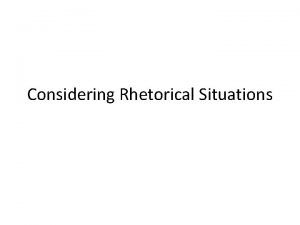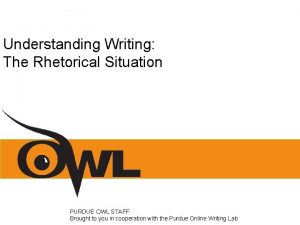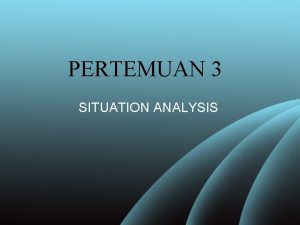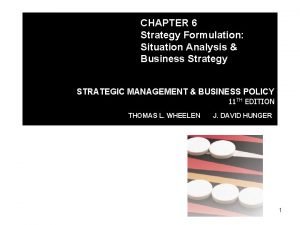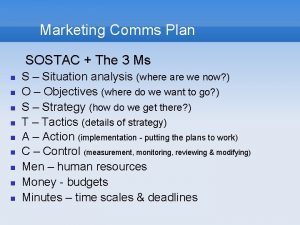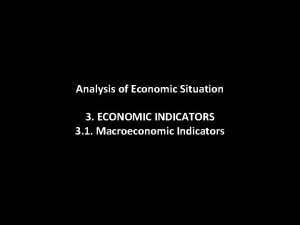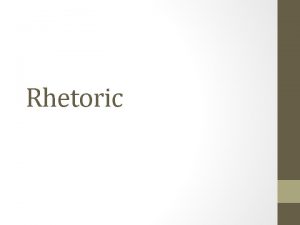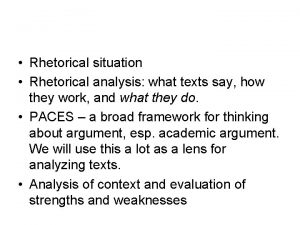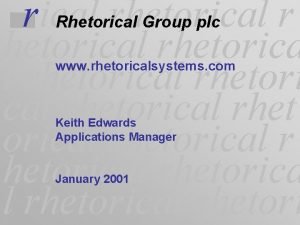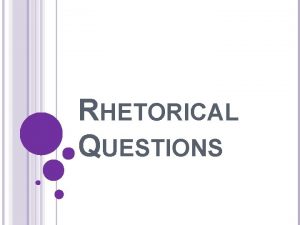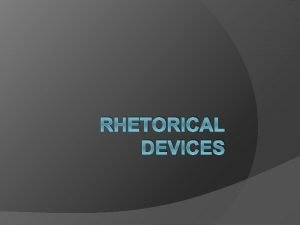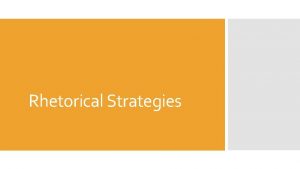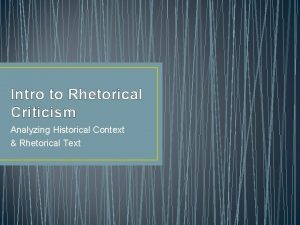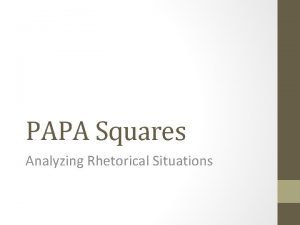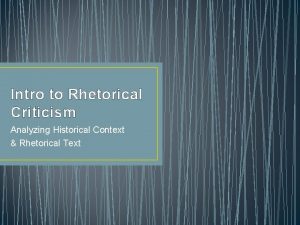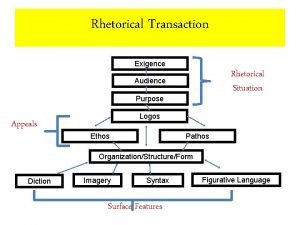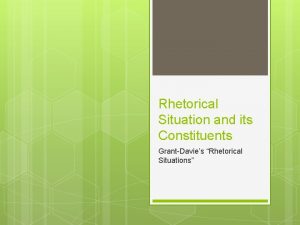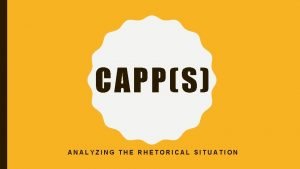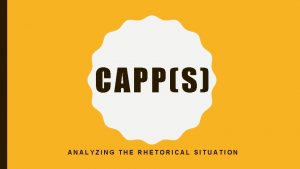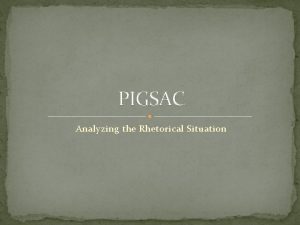Rhetorical Analysis ANALYZING THE RHETORICAL SITUATION What is


















- Slides: 18

Rhetorical Analysis ANALYZING THE RHETORICAL SITUATION

What is Rhetorical Analysis? A rhetorical analysis asks students to look at how a piece of writing (fiction or nonfiction) was written. Basically, students look at the language and structure of the writing.

Questions to Ask • How does the speaker use supporting evidence to appeal to the audience? Are the appeals logical? Emotional? Credible? A combination of all three? • How is the text structured? Is the information organized in a meaningful way to the audience? Is the structure compatible with purpose? Does the organization of information follow established patterns (e. g. classification, description, comparison, problem/solution, etc. )? • How does the language of the text help the text fulfill its purpose to the audience? For example, Is technical or formal language used? Is figurative language used? Is colloquial diction used?

CAPP(S) HOW TO WRITE A RHETORICAL ANALYSIS INTRODUCTION

WHAT IS CAPPS? This acronym will help guide you as you prepare to write your rhetorical analysis introduction. By identifying these elements, you will create a rhetorical situation, which will become your introduction. You will also have set up the focus of your paper by identifying the strategies the author uses to strengthen the claim. • • • C - Context A - Audience P – Persona of Speaker P – Purpose S - Strategies

CAPP(S) Why prepare a rhetorical situation? • Understand the text at a deeper level • Consider all perspectives on the text • Create stronger, focused writing

CONTEXT • Time • Place • People • Events

LET’S LOOK AT “LETTER FROM BIRMINGHAM JAIL” AS IT RELATES TO CONTEXT • Time - 1963 • Place – A letter written in a Birmingham, Alabama jail • People – Martin Luther King Jr. • Events – Letter written after King was arrested for protesting (including marches and sit-ins) during the Birmingham Campaign in the midst of the Civil Rights Movement.

AUDIENCE What do we know about the audience? • Knowledge • Beliefs • Attitudes

LET’S LOOK AT “LETTER FROM BIRMINGHAM JAIL” AS IT RELATES TO AUDIENCE • Martin Luther King Jr. is writing to [white] Fellow Clergymen: – MLK knows that he needs to enlist in help from people respected in the white community. – MLK knows that since he is a minister, he can appeal to other reverends with shared religious beliefs. – MLK knows the clergymen are direct critics of his actions, and he directly [logically] addresses their concerns.

PERSONA OF THE SPEAKER/NARRATOR Persona: The voice (or, sometimes, mask) a writer adopts to tell a story. Voice is usually determined by a combination of subject matter, audience, and the writer’s own feelings about the topic • How does he or she want to be perceived? • What does he or she presume about the audience/readers? • What is the motivational force for the writer?

LET’S LOOK AT KING’S LETTER AS IT RELATES TO PERSONA • As a Black preacher, he is wise and educated about the “dark depths of prejudice and racism” • As an educated man, he is smart enough to recognize that maintaining a moderate and peaceful tone to his fellow brethren will force consideration of issues • As an advocate of “nonviolent direct action” he seeks a platform for negotiation • As a member of the clergy, he is knowledgeable about the Bible and seeks to connect to his audience on a spiritual level. • As a moral man, he justifies breaking immoral laws by quoting another religious figure, St. Augustine, claiming that “an unjust law is no law at all. ”

PURPOSE What is the purpose of the piece? Infinitive phrase (to + strong verb + clarifying explanation ) Examples: To urge Congress to declare war on Japan. To strengthen support for America’s war on terrorism. To guide the nation in a time of terrible tragedy.

LET’S LOOK AT KING’S LETTER AS IT RELATES TO PURPOSE • To remind fellow clergymen that civil disobedience “was practiced by the early Christians, ” and the founding fathers, demonstrating its inherent necessity in the fight for freedom and equality. • To urge other clergymen to open negotiations so that “oppressed people” do not remain oppressed forever. • To address the clergymen’s recent statement to King. • To justify the necessary actions of the civil rights movement

STRATEGIES • • What strategies are used in the text? Why are they significant? how do they tie to the purpose (or rhetorical goal) of the text? Weave a few of them into the rhetorical situation of the introduction.

LET’S LOOK AT THE “LETTER FROM BIRMINGHAM JAIL” AND STRONG STRATEGIES YOU MIGHT HAVE IDENTIFIED Some possibilities might include: • King’s salutation of “My Dear Fellow Clergymen” to demonstrate respect toward his audience regardless of his feelings on the subject • King’s use of Biblical references/analogy to Apostle Paul to illustrate just as Paul carried the gospel of Christ, King carries the gospel of freedom • King’s use of direct diction, especially, when explaining the ”conditions that brought about the demonstrations” (“superficial kind of social analysis”) • The arrangement of King’s argument –beginning with a background of why he’s imprisoned and building his case of inequality with logical counterpoints – and ending with a call to action.

NOW LET’S PUT THIS ALL TOGETHER FOR AN INTRODUCTION. Martin Luther King, Jr. , a civil rights activist and religious leader, serves as an advocate and a representative for “non-violent direct action” as he writes a letter to his critics, “fellow clergymen”, from a Birmingham jail. In direct refutation of their harsh criticism, King urges the clergy to remember the important role civil disobedience played in the Bible, as well as the founding of the United States. Using direct diction and logically-supported counterpoints to invoke both a sense of religious duty, as well as shame for hypocritical practices, King hopes to lift “the dark clouds of racial prejudice” and justify the necessary actions of the civil rights movement. Label the parts of this CAPPS introduction.

RHETORICAL ANALYSIS TIPS FOR WRITING 1. USE PRESENT TENSE VERBS ON YOUR ANALYSIS 2. DON’T DEFINE STRATEGIES 3. IN PARAGRAPH DEVELOPMENT, WRITE WELLDEVELOPED BODY PARAGRAPHS (2 -3 PIECES OF EVIDENCE/PARAGRAPH) 4. THE TOPIC SENTENCE/CONCLUSION SENTENCE SHOULD BE ABOUT PIECE’S CONTENT THAT WAS CHUNKED, NOT A LISTING OF STRATEGIES TO BE ANALYZED IN THAT CHUNK 5. THE “H” SHOULD BE AROUND 2 -3 SENTENCES, A SENTENCE ABOUT THE APPEAL TO THE AUDIENCE AND TWO(ISH) SENTENCES ABOUT THE IMPACT ON THE ARGUMENT.
 Rhetorical situation analysis
Rhetorical situation analysis Analyzing the situation
Analyzing the situation Definition rhetorical mode
Definition rhetorical mode Rhetorical situations definition
Rhetorical situations definition Genre and rhetorical situation
Genre and rhetorical situation Rhetorical analysis purdue owl
Rhetorical analysis purdue owl Contoh sostac
Contoh sostac Present situation analysis
Present situation analysis The role of context in discourse analysis slideshare
The role of context in discourse analysis slideshare Sostac
Sostac Strategic situation analysis adalah
Strategic situation analysis adalah Strategic situation analysis adalah
Strategic situation analysis adalah Situation analysis in marketing
Situation analysis in marketing Economic situation analysis
Economic situation analysis Hát kết hợp bộ gõ cơ thể
Hát kết hợp bộ gõ cơ thể Ng-html
Ng-html Bổ thể
Bổ thể Tỉ lệ cơ thể trẻ em
Tỉ lệ cơ thể trẻ em Voi kéo gỗ như thế nào
Voi kéo gỗ như thế nào



